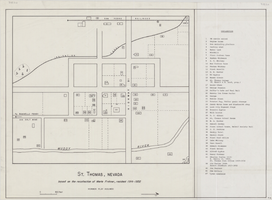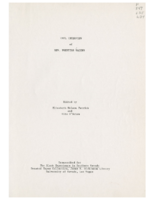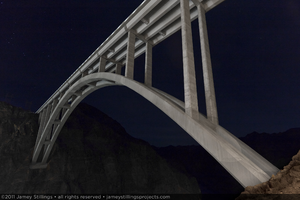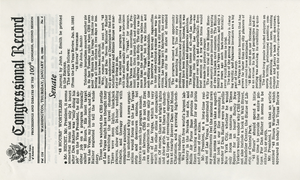Search the Special Collections and Archives Portal
Search Results

Map of St. Thomas, Nevada, circa 1933
Date
Archival Collection
Description
Image
Insignia Films Research for the American Experience: Las Vegas - An Unconventional History
Identifier
Abstract
The Insignia Films Research for the "American Experience: Las Vegas - An Unconventional History" collection (1968, 2004-2005) contains photocopied research material, primarily drawn from Nevada newspapers, photographic prints, Betacam and VHS videotapes with interviews and footage used in the Public Broadcasting System (PBS) series "American Experience: Las Vegas - An Unconventional History," created for the Las Vegas Centennial, Las Vegas, Nevada. Also included are original issues of Look magazine with Las Vegas, Nevada coverage, and a United States Freedom of Information Act (USFOIA) report on Tony Spilotro.
Archival Collection

Photograph of Rioville, Nevada, circa 1900
Date
Archival Collection
Description
Rioville, also known as Bonelli's Landing, Nevada.
Transcribed Notes: Notes on attached sheet: Rioville, Nevada (also known as Bonelli's Landing). It now lies at the bottom of Lake Mead, formed behind Hoover Dam. Rioville was founded by Daniel Bonelli, a Mormon pioneer sent by Brigham Young, about 1865 at the mouth of the Virgin River.
Image

Transcript of interview with Rev. Prentiss Walker by Bernard Timberg, January 27, 1974
Date
Archival Collection
Description
Interview with Rev. Prentiss Walker conducted by Bernard Timberg on January 27, 1974. Born on an Oklahoma Indian Reservation in 1910, Walker arrived in Las Vegas in 1933 in hopes of working on Hoover Dam construction. After working in various jobs, he became ordained as a Baptist minister. Walker discusses job discrimination and living "uptown."
Text

Photograph of the Mike O'Callaghan-Pat Tillman Memorial Bridge, Nevada-Arizona border, January 12, 2011
Date
Archival Collection
Description
Image
Robert Brown oral history interview
Identifier
Abstract
Oral history interview with Robert “Bob” Brown conducted by Ian McLaughlin on February 23, 1981 for the Ralph Roske Oral History Project on Early Las Vegas. Brown discusses his background in the food business working for various hotels and restaurants in the city. Brown discusses some of the developments of the Las Vegas Strip in Nevada, including the opening and closing of various casinos, as well as issues relating to the increasing crime rate, rise in air pollution, and growth in population in the city. Brown also mentions some of the entertainers from the Strip such as Wayne Newton and Frank Sinatra, and he describes the various recreational activities available to Las Vegans in and around the city. The interview concludes with Brown’s discussion about how means of transportation have evolved and how the city has grown since he moved to Las Vegas.
Archival Collection

Transcript of interview with Kim Bird & Pam Fogliasso by Claytee D. White, February 8, 2013
Date
Archival Collection
Description
Kim Bird's family moved to Las Vegas in 1955 when she was twelve years old. Pam Fogliasso arrived in 1954 with her family in 1954, when she was ten. Kim married and had a son and a daughter; she lives in Las Vegas. Pam married, had two children, and lives in Parumph, Nevada. Though Kim and Pam moved here in the mid-1950s, they had family members who had lived in Southern Nevada and worked on building Hoover Dam - Kim's grandfather and Pam's great-uncle. Both women remember growing up in a Las Vegas that was run by the mob and safe for teenagers; meeting friends in local hangouts such as the Blue Onion and attending sock hops, babysitting, and cruising down Fremont Street. They attended high school with black students but were also aware of the segregation that existed on the Strip. This interview focuses on Kim and Pam's experiences growing up in Las Vegas, and on their teenaged years attending Rancho High School.
Text

Transcript of interview with Edith Allan by Elizabeth Cleary, February 26, 1977
Date
Archival Collection
Description
Text

